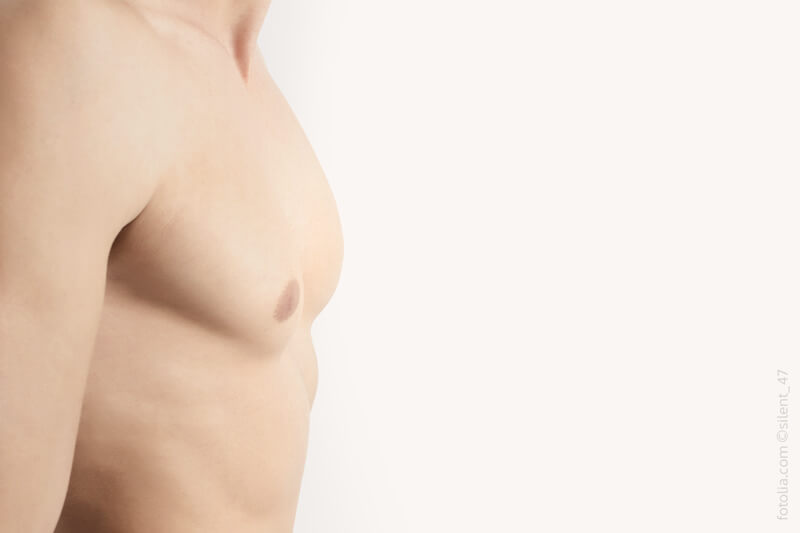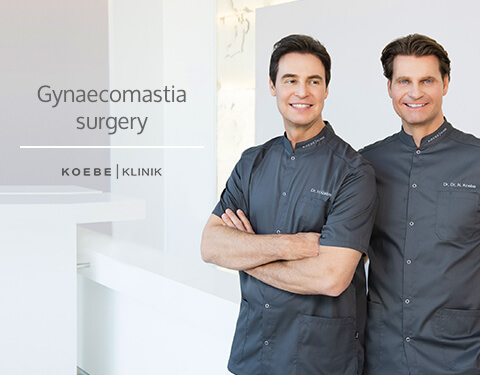GYNAECOMASTIA SURGERY AT
THE KOEBE KLINIK
Our society regards a masculine, defined torso as the epitome of male beauty. At the same time, it has come to place far greater aesthetic demands on male bodies. This becomes all the more troubling when a man’s chest takes on a rather feminine shape. While men’s chest muscles usually respond well to exercise, if a man is genetically predisposed to developing glandular tissue or fatty deposits below their nipples, any attempt to exercise the fat away is almost hopeless. Strict diets are also rarely able to achieve sufficient reductions in breast size.
Gynaecomastia – also pejoratively referred to as “man boobs” – creates a stigma as men grow older, particularly over the age of 40. If a man has a genetic predisposition, however, it can also affect younger men during puberty, usually due to changes in their hormonal balance and metabolism.
The abnormal increase in glandular tissue causes the male breast to grow until it has a feminine appearance. In addition to “real” gynaecomastia, in which the individual presents with a markedly enlarged mammary gland, men can also suffer from what is known as pseudogynaecomastia –an enlarged breast due to localised fat accumulations. Pseudogynaecomastia typically occurs during middle age or due to obesity; however, it can also present in conjunction with “real” gynaecomastia.
Typical, pubertal gynaecomastia is a different condition and, in many cases, also regresses spontaneously. For some men, however, this is not the case, and their breasts remain permanently enlarged. An operation is also a potential option in such instances once the causes have been fully ascertained. Furthermore, other factors such as chronic diseases, specific medications, hair growth agents, anabolic steroids and so on can cause a man’s chest to take on a feminine appearance. The man concerned often has to endure taunts and teasing because summer clothes and sportswear are unable to hide the condition sufficiently.
In the case of gynaecomastia, just as with all symptoms treatable with plastic surgery, it is important not to wait until the skin becomes permanently stretched due to the excess volume and the excess skin becomes unable to fully recede after treatment.
In light of the complex causes and the demanding surgical technique – which must not be underestimated – the surgery to correct gynaecomastia requires a high level of expertise and experience. Contrary to popular opinion, gynaecomastia surgery to remove fat and/or glandular tissue is a very challenging technical procedure that demands a particularly experienced surgeon and exceptionally delicate work. The plastic surgeon must be acutely familiar with the specific contours of the male torso and have mastered the specific combination techniques (both removing glandular tissue and removing fat tissue) used to treat gynaecomastia. Only then can the procedure be expected to achieve aesthetic results that do not worsen the issue with wide-reaching scars or deep indentations.

Before the treatment, we will need to hold several preliminary examinations to clarify as precisely as possible the causes of the localised fat accumulations. Only an experienced specialist can determine whether surgery is required or a more conservative treatment could deliver results.
The KOEBE KLINIK is your specialist clinic for gynaecomastia surgery in the Düsseldorf region.
At our clinic, gynaecomastia surgeries are always personally performed by our senior physician. Dr Hermann Koebe has many years of experience as well as intimate knowledge of the many crucial nuances that require particular attention when shaping the male chest.
Depending on your situation, different surgical techniques might be used in the surgery. Our specialist removes enlarged glandular tissue using tissue-conserving techniques that result in minimal scarring. He makes the smallest possible incisions in inconspicuous locations around the patient’s areola. The art of this surgery lies in achieving the most even results possible. Removing all the glandular tissue would be a radical approach and would create indentations around the nipples that could prove very difficult to correct.
In the case of pseudogynaecomastia, we only remove excess fat tissue. To achieve this, we perform liposuction at an inconspicuous place, which does not involve significant incisions. It is important to ensure, for example, that the breast muscles (m. pectoralis) in the lower and lateral part of the chest are contoured harmoniously and that too much tissue is not removed from the upper section of the chest, which is often not as enlarged. In most cases, the enlargement is due to a mix of glandular and fat tissue. Depending on your individual case, it may therefore be recommended to adopt a different surgical procedure combining both approaches.
Would you be interested in further information on gynaecomastia surgery with no obligation to proceed? If so, make an appointment at the KOEBE KLINIK. In a personal consultation with Dr Koebe, he will advise you of the surgery procedure most suitable for you and the results you can expect to achieve.
FAQS ABOUT
GYNAECOMASTIA SURGERY
IN DÜSSELDORF
What is gynaecomastia?
Gynaecomastia is an abnormal increase in the size of the male mammary gland. The condition is usually caused by hormonal issues but can also be due to age-related changes in a man’s metabolism, chronic diseases or medication.
Gynaecomastia often occurs during puberty and, in most cases, goes on to subside of its own accord. In some young men, however, this regression does not take place.
In addition to “real” gynaecomastia, some people suffer from what is known as pseudogynaecomastia. This is not caused by excess glandular tissue but rather by fat accumulations in the chest region. This can also cause a man’s breast to appear visibly more feminine.
Who could benefit from gynaecomastia surgery?
In principle, gynaecomastia surgery is suitable any men suffering from enlarged breasts which appear feminine. Before the procedure, however, it is crucial to rule out pathological or hormonal causes. It is crucial to determine in advance whether the gynaecomastia may be due to hormonal issues as the issues could otherwise reoccur after the procedure.
Gynaecomastia can also be caused by medications or anabolic steroids. This is another possibility to consider when planning treatments before electing for a surgical procedure.
In the case of pseudogynaecomastia, it may sometimes be necessary for patients to lose some weight. If the patient still has significantly enlarged breast even after weight loss, a surgical procedure to correct this could be highly beneficial once any medical contraindications have been excluded.
Gynaecomastia surgery is a challenging procedure; however, it promises a very good chance of success and the rewards are considerable. As a fundamental rule, it is also important not to postpone the procedure for too long because, if the skin in the breast area becomes overstretched, this could impact on the final aesthetic results due to the reduced elasticity of the skin.
What does gynaecomastia surgery involve?
Before gynaecomastia surgery, the physician treating you will carry out a detailed consultation. He will inform you about your treatment options, alternative methods and the surgery’s prospects of success. In addition, some examinations need to be carried out to identify the cause of the gynaecomastia or the enlarged male breast.
If conservative, non-surgical measures fail to provide the desired success, we would then consult you and take the decision on whether to perform surgery together.
The steps in gynaecomastia surgery can vary depending on the specific case. In the case of “real” gynaecomastia, the excess glandular tissue is removed via small incisions in the skin. Depending on the scope of the treatment and the patient’s wishes, the procedure can be performed under local anaesthetic or twilight sedation. For more extensive procedures, we recommend engaging an anaesthetist to allow the surgery to be performed under general anaesthetic.
In the case of pseudogynaecomastia or a mixed form of the conditions (in which the patient presents with excess glandular tissue and excess fat tissue), the surgeon first removes the excess fat tissue. This requires a surgeon with specific experience and a clear understanding of the male breast so that it does not subsequently appear drooping, indented, irregular or pointed. The procedure uses special cannulas inserted via tiny incisions in the armpit area and/or near the intramammary line. No major incisions are involved.
In extreme cases, such as following massive weight loss and irreversibly sagging skin, the plastic surgeon may also lift the surrounding skin.
Depending on the scope of the operation, it may be worthwhile for you to spend one night as an inpatient in our licensed, specialist clinic. If you choose to do so, you will receive round-the-clock care from our certified nursing team until you are discharged.
What should I consider before and after gynaecomastia surgery?
You must stop taking blood-thinning and anticoagulant medications at least 14 days before the operation. This also includes some over-the-counter flu medication and painkillers such as acetylsalicylic acid or aspirin. The specialist treating you will be glad to advise you of the alternatives open to you prior to treatment.
After the operation, we will apply a compression bandage that you will wear for several days. You will also be required to wear a special compression garment (elastic compression vest) for at least 2 weeks – but ideally for a period of 4 weeks up to a maximum of 6 weeks.
You should refrain from physical exertion and avoid strenuous activities for the first few weeks. You can start to exercise again after about 4 to 6 weeks and may be able to perform light physical activities even sooner.
You should avoid exposing the treated areas to direct sunlight for at least 3 to 6 months to prevent the scars from become discoloured (due to pigment disorders).
What are the risks associated with gynaecomastia surgery?
Like any operation, gynaecomastia surgery involves general surgical risks. In rare, isolated cases, patients can develop infections, wound healing disorders, post-operative bleeding and sensory disturbances. It is important to remember that, if an operation is performed improperly or without due care and attention, patients can develop an irregular skin texture (indentations) or broad scars. Contouring the male chest also requires a plastic surgeon with a clear vision and an advanced understanding of the specific 3D structure of the male thorax. If these conditions are not met, the results may be aesthetically unsatisfactory even if the medical aspect – removing the enlarged breast tissue – has been successful.
Essentially, it would be fair to describe gynaecomastia surgery as a rather low-risk procedure with advanced aesthetic requirements.
Here at the KOEBE KLINIK, Dr Koebe personally performs all surgeries of this type. This means you can rest assured you will be in the very best, most experienced hands with us.
When will my health insurance pay for gynaecomastia surgery?
If there is a demonstrable psychological or physical impairment, some health insurance providers will accept the costs of gynaecomastia surgery. The requirements that must be met may vary depending on the health insurance provider. However, the costs of liposuction are not usually covered. That also means that such a gynaecomastia operation (covered by health insurance) cannot include liposuction; the procedure is therefore limited to removal of glandular tissue – the extent of which may vary – and while not include the delicate aesthetic shaping that liposuction can achieve. This limited procedure is not usually sufficient to achieve the best possible result; in some cases, the psychological damage could be even greater after the procedure. The number of unnecessary corrective surgeries we perform (scar correction, filling in indentations) confirm our belief that, while there may be a fundamental medical justification for this procedure, it is essential that it is performed with the requisite aesthetic vision and expertise.
BENEFITS OF
GYNAECOMASTIA SURGERY
AT THE KOEBE KLINIK
- Senior physician treatment: At the KOEBE KLINIK, gynaecomastia surgery is always performed by our senior physician, Dr Hermann Koebe. This affords you the certainty of being treated by an experienced, specialist plastic surgeon.
- High aesthetic standards and profound knowledge of the specific contours of the male chest – a crucial requirement for satisfactory results.
- Discretion: Your privacy is our highest priority. All appointments are thus held in a discreet atmosphere of trust. Our premises feature private parking spaces and a sheltered entrance to ensure maximum discretion.
- Central location: The KOEBE KLINIK is situated just a few minutes from Düsseldorf. Does your job mean you need an appointment outside our regular business hours? If so, we’d be happy to make the necessary arrangements.
Contact

Contact
KOEBE KLINIK
Niederlöricker Str. 33
40667 Meerbusch
near Düsseldorf
Location Google Maps
Opening hours
Monday to Friday 9.00 am - 6.00 pm
We are available to you 24/7!





